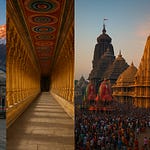Nestled on the serene banks of Pushpavati River in the quaint village of Modhera, approximately 30 km from Mehsana in Gujarat, stands a timeless testament to India's ancient solar worship traditions — the Modhera Sun Temple (मोढेरा सूर्य मंदिर). Dedicated to Surya Bhagwan (the Sun God), this temple is not merely a structure, but a living document etched in sandstone, astronomy, devotion, and cosmic symbolism.
Built over a millennium ago, this temple predates the Konark Sun Temple in Odisha, yet it remains lesser known, veiled in mystery, precision, and astonishing architectural mastery. Let us journey through its origin, mysteries, rituals, structure, spirituality, and everything in between.
🪔 Historical Origins & Foundation
Founded by: King Bhima I of the Solanki dynasty in 1026-27 CE
Architecture style: Maru-Gurjara (Chaulukya style), symbolizing peak craftsmanship of the period
Inspiration: The Solankis considered themselves descendants of Surya, thus patronizing sun temples
Impact of Mahmud of Ghazni: Around the same era, Ghazni raided parts of Gujarat; however, the temple’s structure endured the test of time, standing as a symbol of resilience and spiritual pride.
🧱 Architectural Grandeur
The Modhera Sun Temple is divided into three key segments, aligned in an East-West axis so that the first rays of the sun fall directly on the deity's sanctum during equinoxes.
1. Surya Kund (Stepwell / Reservoir)
Also known as Ram Kund, this rectangular stepped tank measures about 100 sq. ft.
Contains 108 miniature shrines (symbolic of 108 energy points or marma) dedicated to various deities
Used for ritual cleansing before entering the temple
The stepwell itself is a sacred symbol of purification before enlightenment
2. Sabha Mandapa (Assembly Hall)
The most mystifying feature — has 52 intricately carved pillars
Each pillar represents a week of the year, symbolizing cyclical time
Detailed sculptures depict scenes from Ramayana, Mahabharata, and Puranas
This space was used for religious gatherings, discourse, and chanting
3. Guda Mandapa (Sanctum Sanctorum)
Once held the idol of Surya Dev, which no longer exists due to invasions
Designed in a way that the first sunray during equinoxes would illuminate the deity's crown
A symbol of divine awakening — where cosmos and consciousness met
🕉️ Mystical and Scientific Marvels
Solar Alignment: The temple is engineered so precisely that during equinoxes, sunlight would directly fall on the Garbhagriha
Numerological Sacredness: 52 pillars = 52 weeks, 108 shrines = 108 sacred numbers in Hinduism
No idols now: Possibly destroyed during Ghazni’s invasion, leaving the temple as an archeological and spiritual ruin, still radiating divinity
Acoustic brilliance: In Sabha Mandapa, chanting or bhajans reverberate with spiritual echo
The temple is not in use for active worship today — yet it is considered a sacred pilgrimage site
📿 Puja, Rituals & Aarti (Past Traditions)
Though active worship ceased centuries ago, historians and scriptures suggest the following rituals:
🪔 Sandhya Arghya
Devotees offered water to the rising and setting sun, facing east in the morning and west at dusk.
🧘♂️ Surya Namaskar & Meditation
The temple served as a spiritual center for practicing yoga, especially Surya Namaskar, meditation, and Vedic chanting.
🕯 Bhajan-Kirtan in Sabha Mandap
Sabha Mandap was used for bhajan gatherings, spiritual storytelling, and community satsangs.
🔥 Yajnas & Homas
Fire offerings to Surya for health, prosperity, and inner purification were integral parts of temple rituals.
🎶 Bhajans and Hymns to Surya
Many Vedic hymns were recited here, notably from the Rigveda and Yajurveda, such as:
Aditya Hridayam – A powerful hymn sung by Rishi Agastya to Lord Rama before his battle with Ravana.
Gayatri Mantra – A universal chant invoking the solar deity as the illuminator of consciousness.
Surya Ashtakam, Surya Kavacham, and Surya Stotram were also chanted in different mandapas.
✨ Spiritual Significance
Worship of light – Surya represents light, life force, vitality, truth, and healing
Practicing rituals here was believed to remove darkness from the soul
Temple serves as an energy vortex — a place to align oneself with cosmic rhythms and inner light
The 52-pillared Sabha Mandapa signifies that spirituality must be practiced every week — not occasionally
The kund's 108 shrines symbolize the macro-microcosmic connection — each individual connected with the universe
🧳 Travel and Visit Guide
📍 Location
Village: Modhera, District Mehsana, Gujarat
Nearest City: Ahmedabad (approx. 100 km)
Nearby Attraction: Rani ki Vav (UNESCO site), Patan
🛤 How to Reach
By Air: Ahmedabad Airport (International & Domestic)
By Train: Mehsana Railway Station
By Road: Connected via NH-947; taxis and buses easily available
🏨 Accommodation
Stay options in Mehsana or Patan – budget to mid-range hotels available
Gujarat Tourism also provides guest houses nearby
🕰 Best Time to Visit
October to March – Pleasant weather and better daylight for photography
Modhera Dance Festival (Uttarardh Mahotsav) in January is a spectacular cultural experience amid temple lights
🪔 Festivals and Celebrations
Modhera Dance Festival: Celebrated by Gujarat Tourism, featuring classical Indian dance forms in the backdrop of the temple
Ratha Saptami: Celebrates Surya Jayanti (Surya’s birthday), often associated with special gatherings
Makar Sankranti: Symbolic solar transition day, associated with spiritual awakening
🔱 Devotee Experience
Even though the temple doesn’t house an idol anymore, devotees describe the place as overwhelmingly sacred:
“When the first rays of the sun touch the steps of the Surya Kund, you feel as though time has bowed to divinity.”
— A devotee from Varanasi
Many travelers meditate here, sit near the kund in silence, or walk barefoot through the pillars, feeling vibrations, peace, and spiritual awakening.
🧩 The Mystery of Silence and Survival
Why is no idol present?
Likely due to invasions and desecration, though the core structure survived miraculously.Why are the acoustics so perfect?
Built with sonic geometry, ancient architects ensured that chants create harmonic resonance, ideal for meditation and rituals.Why was it abandoned?
After the idol’s destruction, worship shifted to nearby temples, but Modhera remained a symbol of architectural defiance and spiritual timelessness.
📜 Legacy and Importance Today
A nationally protected monument under Archaeological Survey of India (ASI)
A source of inspiration for modern solar temples, Vastu science, and energy architecture
Symbol of India’s scientific, spiritual, and artistic unity
The Modhera Sun Temple is not just an architectural wonder; it is a portal through time, a sunlit scripture in stone, where devotion meets science, and time bows before the divine.
It is a reminder of India's eternal reverence for light, both physical and metaphysical. It’s where every pillar speaks, every shadow teaches, and every sunrise consecrates the soul.
🛕 Har Har Mahadev! Jai Surya Narayan! 🌞
#ModheraSunTemple #LostTemples #SanatanDharma #SunWorship #Bhakti #IndiaSpiritualHeritage #VedicWisdom #ArchitecturalMarvel #SuryaDev #HinduTemples










